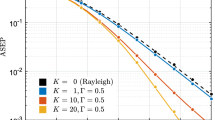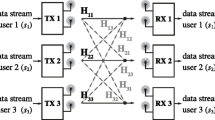Abstract
Indoor radio communication in the 20–60 GHz band using TDMA with differentially encoded QPSK is consideed. A burst-type transmission, based on a basic time slot consisting of a preamble for synchronization and equalizer training and of an information data section, is adopted. We employ fractionally spaced decision feedback equalization and give the relevant analytical and simulated performance results in terms of Doppler frequency. An upper limit is determined for the channel variations which can be tracked by the equalizer. Performance results are obtained for equalization with and without carrier phase recovery. Calculated and simulated probability of error show that error propagation degrades the performance by about 6 dB at a bit error rate of 10−3 for a channel without any diversity. However, the effect of past decision errors is negligible for dual diversity. Numerical stability, required accuracy, and hardware complexity are also discussed.
Similar content being viewed by others
References
T. A. Sexton and K. Pahlavan, Channel modeling and adaptive equalization of indoor radio channels,IEEE Journal on Selected Areas in Communications, Vol. SAC-7. pp. 114–121, 1989.
R. A. Valenzuela, Performance of adaptive equalization for indoor radio communications,IEEE Transactions on Communications, Vol. COM-37, No. 3, pp. 291–293, 1989.
A. Zigic and R. Prasad, Bit error rate of decision feedback equalizer for indoor wireless communications,Electronics Letters, Vol. 28, pp. 1949–1950, 1992.
P. F. M. Smulders and H. T. Muskens, Performance of decision feedback equalization in mm-wave indoor radio systems, in 2ndIEEE International Conference on Universal Personal Communications, pp. 890–893, 1993.
K. Pahlavan, S. J. Howard, and T. A. Sexton, Decision feedback equalization of the indoor radio channel,IEEE Transactions on Communications, Vol. COM-41, No. 1, pp. 164–170, 1993.
J. W. C. Jakes,Microwave Mobile Communications, Wiley, New York, 1974.
P. Monsen, Theoretical and measured performance of a DFE modem on a fading multipath channel,IEEE Transactions on Comunications. Vol. COM-25, No. 10, pp. 1144–1153, 1977.
A. Masoomzadeh-Fard and S. Pasupathy, Nonlinear equalization of multipath fading channels with noncoherent demodulation, to be published inIEEE Journal on Selected Areas in Communications, April 1996.
A. Masoomzadeh-Fard and S. Pasupathy, Nonlinear equalization of selective fading channels with differentially coherent PSK, inIEEE Military Communications Conference, pp. 175–179, 1995.
P. Sehier and G. K. Kaleh, Adaptive equalizer for differentially coherent receiver,IEE Proceedings, Vol. 137, pp. 9–12, 1990.
R. J. Tracey. An incoherent adaptive mean square equalizer, inProceedings of International Conference on Communications, pp. 9F.1–9F.5, 1974.
R. J. C. Bultitude, Measurement, characterization and modeling of indoor 800/900 MHz radio channels for digital communications,IEEE Communications Magazine, Vol. 25, pp. 5–12, 1987.
N. C. Currie and C. E. Brown (editors).Principles and Applications of Millimeter-Wave Radar, Artech House, Norwood, MA, 1987.
R. D. Gitlin, E. Y. Ho, and J. E. Mazo, Passband equalization of differentially phase-modulated data signals,Bell System Technical Journal, Vol. 52, pp. 219–238, 1973.
D. D. Falconer, Jointly adaptive equalization and carrier recovery in two-dimensional digital communication systems,Bell System Technical Journal, Vol. 55, pp. 317–334, 1976.
A. A. M. Saleh and R. A. Valenzuela, A statistical model for indoor multipath propagation,IEEE Journal on Selected Areas in Communications, Vol. SAC-5, pp. 128–137, 1987.
P. F. M. Smulders and A. G. Wagemans, A statistical model for the mm-wave indoor radio channel, inSixth IEEE International Symposium on Personal, Indoor and Mobile Radio Communications (PIMRC 92), pp. 303–307, 1992.
J. G. Proakis,Digital Communications, 2nd ed., McGraw-Hill, New York, 1989.
C. Despins, D. Falconer, and S. Mahmoud, Impact of a non-fading Gaussian characterization of interference on portable radio link analysis,IEEE Transaction on Communications, Vol. 42, No. 2/3/4, pp. 396–402, 1994.
P. Monsen, Digital transmission performance on fading dispersive diversity channels,IEEE Transaction on Communications, Vol. COM-21, No. 1, pp. 33–39, 1973.
C. A. Belfiore and J. H. Park, Decision feedback equalization,IEEE Proceedings, Vol. 67, pp. 1143–1158, 1979.
D. L. Duttweiler, J. E. Mazo, and D. G. Messerschmitt, An upper bound on the error probability in decision-feedback equalization,IEEE Transaction on Information Theory, Vol. 20, pp. 490–497, 1974.
E. Eleftherious, Adaptive equalization techniques for HF channels,IEEE Journal on Selected Areas in Communications, Vol. SAC-5, pp. 238–243, 1987.
F. M. Hsu, Square-root kalman filtering for high speed data received over fading dispersive HF channels,IEEE Transaction on Information Theory, Vol. 28, pp. 753–763, 1982.
F. Ling and J. G. Proakis, Adaptive lattice decision feedback equalizers-their performance and application to time variant multipath channels,IEEE Transaction on Communications, pp. 348–356, April 1985.
F. Ling and J. G. Proakis, Nonstationary learning characteristics of least squares adaptive estimation algorithms, inProceedings of International Conference on Acoustics, Speech and Signal Processing, pp. 3.7.1.–3.7.4, 1984.
B. Toplis and S. Pasupathy, Tracking improvements in fast RLS algorithms using a variable forgetting factorIEEE Transaction on Acoustics, Speech, and Signal Processing, Vol. 36, pp. 206–227, 1988.
L. Ling, D. Manolakis, and J. G. Proakis, Finite word-length effects in recursive least squares algorithms with application to adaptive equalization,Annals of Telecommunications, Vol. 41, No. 5, 1986.
D. M. Lewis, Interleaved memory function interpolators with application to an accurate LNS arithmetic unit,IEEE Transaction on Computers, Vol. 43, pp. 974–982, 1994.
G. D'Aria, R. Piermarini, and V. Zingarelli, Fast adaptive equalizers for narrow-band TDMA mobile radio,IEEE Transaction on Vehicular Technology, Vol. 40, pp. 392–404, 1991.
C. W. Moreland, An 8b 150 MSamples/s serial ADC, inISSCC Digest of Technical Papers, pp. 272–273, Feb. 1995.
B. Razavi and J. Sung, A 200 MHz 15 mW BiCMOS sample- and-hold amplifier with 3V supply, inISSCC Digest of Technical Papers, pp. 56–57, Feb. 1995.
A. Shoval,Analog adaptive filtering techniques for high-speed data communications, Ph.D. thesis, University of Toronto, Dept. of Electrical Engineering, Jan. 1995.
Author information
Authors and Affiliations
Rights and permissions
About this article
Cite this article
Masoomzadeh-Fard, A., Pasupathy, S. Adaptive equalization of indoor radio channels for 156-Mb/s, QPSK data transmission. Int J Wireless Inf Networks 3, 105–115 (1996). https://doi.org/10.1007/BF02107051
Issue Date:
DOI: https://doi.org/10.1007/BF02107051




